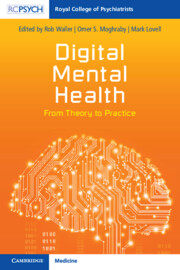Book contents
- Digital Mental Health
- Digital Mental Health
- Copyright page
- Contents
- Contributors
- Introduction
- Chapter 1 Working with IT Systems
- Chapter 2 Technology-Enabled Care
- Chapter 3 Note Keeping in the Digital Age
- Chapter 4 Big Data
- Chapter 5 Artificial Intelligence
- Chapter 6 Digital Clinicians
- Chapter 7 Global Telepsychiatry
- Chapter 8 The Integration Agenda
- Chapter 9 Digital Wellbeing
- Chapter 10 Conclusion
- Appendix: Abbreviations
- Index
- References
Chapter 9 - Digital Wellbeing
Using Technology Well
Published online by Cambridge University Press: 23 November 2023
- Digital Mental Health
- Digital Mental Health
- Copyright page
- Contents
- Contributors
- Introduction
- Chapter 1 Working with IT Systems
- Chapter 2 Technology-Enabled Care
- Chapter 3 Note Keeping in the Digital Age
- Chapter 4 Big Data
- Chapter 5 Artificial Intelligence
- Chapter 6 Digital Clinicians
- Chapter 7 Global Telepsychiatry
- Chapter 8 The Integration Agenda
- Chapter 9 Digital Wellbeing
- Chapter 10 Conclusion
- Appendix: Abbreviations
- Index
- References
Summary
Digital processes need to have wellbeing at their core. Rather than focusing on burnout and distress, digital can be considered as an enabler of wellness. Using key concepts such as user-centred design, reimagining processes and education, digital can enhance the lives of staff and patients. Many solutions to digital distress involve taking a break from technology. These solutions are temporary and do not address the root cause of the issue. As technology embeds itself into every facet of our lives, we have an opportunity to take control of how we engage with digital. Instead of translating paper processes into digital equivalents there is an opportunity to leverage the power digital brings to reduce the burden rather than add to it. Clinician and patient engagement are key to digital wellbeing and the success of digital in our healthcare systems. Increasing autonomy and providing flexible support can reduce burnout with digital systems. Involvement must be meaningful and not acceptability testing at the end of system design. Critically, we must remember that people are the most important determinant of the success of any digital project.
- Type
- Chapter
- Information
- Digital Mental HealthFrom Theory to Practice, pp. 108 - 121Publisher: Cambridge University PressPrint publication year: 2023



